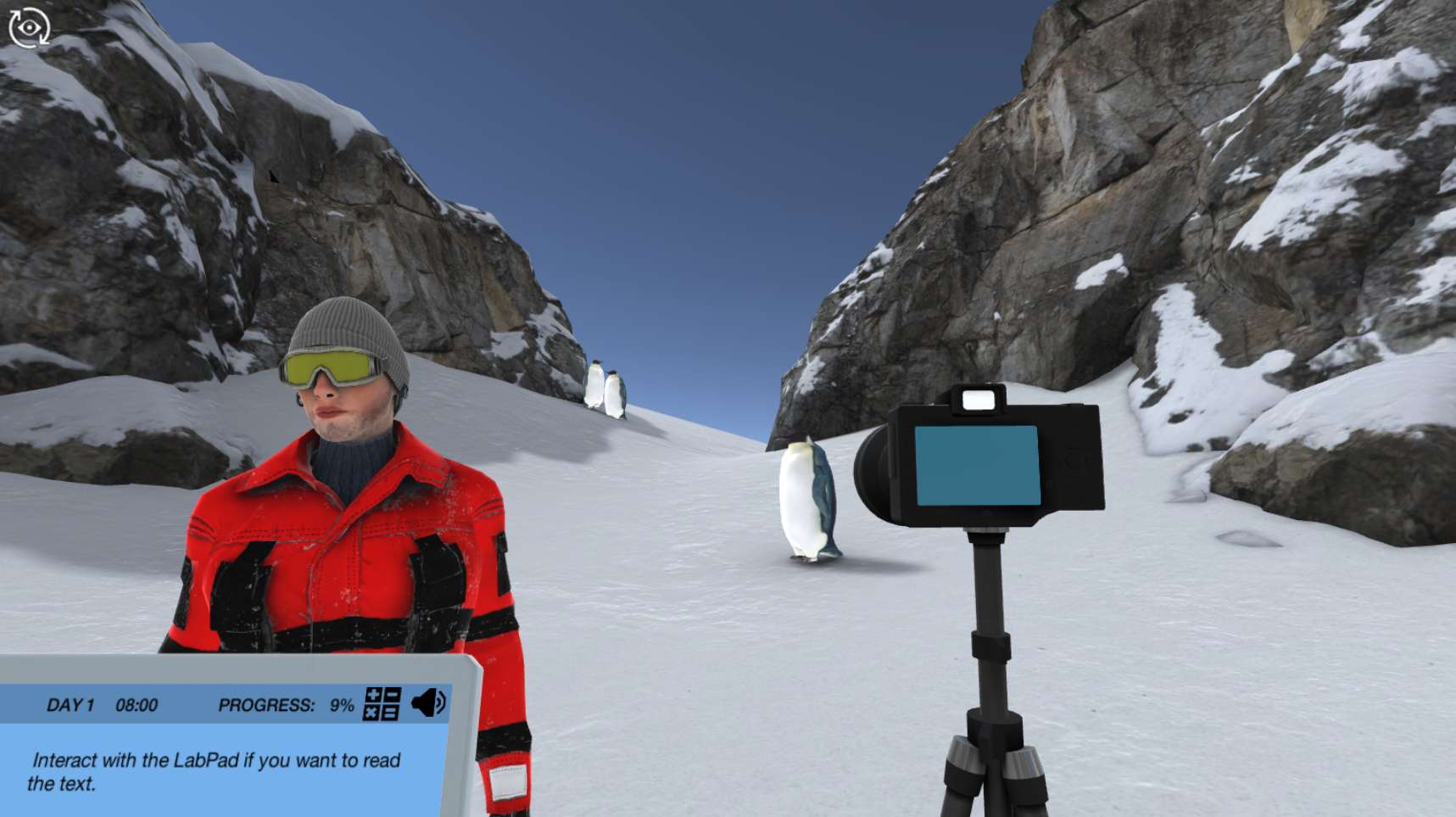Heading 1
Heading 2
Heading 3
Heading 4
Heading 5
Heading 6
Lorem ipsum dolor sit amet, consectetur adipiscing elit, sed do eiusmod tempor incididunt ut labore et dolore magna aliqua. Ut enim ad minim veniam, quis nostrud exercitation ullamco laboris nisi ut aliquip ex ea commodo consequat. Duis aute irure dolor in reprehenderit in voluptate velit esse cillum dolore eu fugiat nulla pariatur.
Block quote
Ordered list
- Item 1
- Item 2
- Item 3
Unordered list
- Item A
- Item B
- Item C
Bold text
Emphasis
Superscript
Subscript
About This Simulation
Visit Antarctica to take the perfect picture of a penguin! You will get help from Albert Einstein, who will teach you how reflection and refraction of light affect the photos you take among the snow and ice.
Learning Objectives
- Understand the wave/particle duality of light and how it explains the different features of electromagnetic radiation
- Apply the law of reflection and refraction to predict how light interacts with interfaces
About This Simulation
Lab Techniques
- Optical table
Related Standards
- HS-PS4-3, HS-PS4-4, HS-PS4-5
- 10.1 Properties of Waves
- 4.4 Wave behaviour
Learn More About This Simulation
Join photographer Nicholas on his expedition to Antarctica to photograph the wildlife. In this simulation, you will learn about the wave-like behaviors of light. When light travels from one medium into another, the rays can reflect off of the surface. Depending on the angle and the media, the light can also refract. The angle of refraction is described by Snell’s law. You will experiment with different media and angles at the optical table to see Snell’s law in action.
Travel to the Antarctic
Meet photographer Nicholas in the Antarctic who is about to take the perfect photograph of a penguin - or is he? There is a lot of reflective snow and ice in the Antarctic and this will affect how much light Nicholas sees in his finished photographs. Can you help him optimize the settings of his camera?
Meet Einstein in the lab
To learn more about light, join Albert Einstein in the physics lab. You will have the option to first explore the electromagnetic spectrum and discover the similarities and differences between different types of electromagnetic radiation. Alternatively, you can dive straight into visible light.
Experiment with mirrors and glaciers
Learn how light is reflected and refracted when travelling from one medium to another. What happens to light when it hits a mirror? And how about an Antarctic glacier? Together with Albert Einstein, you will set up your own optical table with a laser, mirrors and glacier samples and discover what happens to a laser beam when it hits these media.
Optimize the camera settings
Now that you are an expert in reflection and refraction, you understand why Nicholas’ photo looked the way it did. Help him to get the optimal amount of light into his camera and capture that perfect picture!
For Science Programs Providing a Learning Advantage
Boost STEM Pass Rates
Boost Learning with Fun
75% of students show high engagement and improved grades with Labster
Discover Simulations That Match Your Syllabus
Easily bolster your learning objectives with relevant, interactive content
Place Students in the Shoes of Real Scientists
Practice a lab procedure or visualize theory through narrative-driven scenarios


FAQs
Find answers to frequently asked questions.
Heading 1
Heading 2
Heading 3
Heading 4
Heading 5
Heading 6
Lorem ipsum dolor sit amet, consectetur adipiscing elit, sed do eiusmod tempor incididunt ut labore et dolore magna aliqua. Ut enim ad minim veniam, quis nostrud exercitation ullamco laboris nisi ut aliquip ex ea commodo consequat. Duis aute irure dolor in reprehenderit in voluptate velit esse cillum dolore eu fugiat nulla pariatur.
Block quote
Ordered list
- Item 1
- Item 2
- Item 3
Unordered list
- Item A
- Item B
- Item C
Bold text
Emphasis
Superscript
Subscript
A Labster virtual lab is an interactive, multimedia assignment that students access right from their computers. Many Labster virtual labs prepare students for success in college by introducing foundational knowledge using multimedia visualizations that make it easier to understand complex concepts. Other Labster virtual labs prepare learners for careers in STEM labs by giving them realistic practice on lab techniques and procedures.
Labster’s virtual lab simulations are created by scientists and designed to maximize engagement and interactivity. Unlike watching a video or reading a textbook, Labster virtual labs are interactive. To make progress, students must think critically and solve a real-world problem. We believe that learning by doing makes STEM stick.
Yes, Labster is compatible with all major LMS (Learning Management Systems) including Blackboard, Canvas, D2L, Moodle, and many others. Students can access Labster like any other assignment. If your institution does not choose an LMS integration, students will log into Labster’s Course Manager once they have an account created. Your institution will decide which is the best access method.
Labster is available for purchase by instructors, faculty, and administrators at education institutions. Purchasing our starter package, Labster Explorer, can be done using a credit card if you are located in the USA, Canada, or Mexico. If you are outside of North America or are choosing a higher plan, please speak with a Labster sales representative. Compare plans.
Labster supports a wide range of STEM courses at the high school, college, and university level across fields in biology, chemistry, physics, and health sciences. You can identify topics for your courses by searching our Content Catalog.















